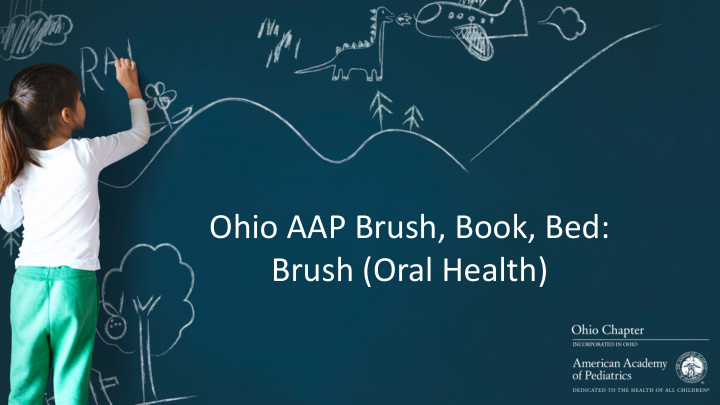



Ohio AAP Brush, Book, Bed: Brush (Oral Health)
CME Disclaimer I have no personal financial relationships in any commercial interest related to this CME. I do not plan to reference off label/unapproved uses of drugs or devices. James Duffee, MD, MPH james.duffee@wright.edu
Learning Objectives • Promote positive oral health routines with patients beginning at 6 months of age • Understand and implement fluoride varnish procedures • Discuss early literacy with families during pediatric well visits and other encounters • Improve knowledge of appropriate sleep habits and advise patients with sleep related concerns
https://www.youtube.com/watch?v=3dup3IArSNs
Anticipatory Guidance: Infant • Continue breastfeeding as foods are introduced for 1 year or longer. • Discourage putting a child to bed with a bottle. Wean from a bottle by 1 year of age. If still using bottle at bedtime, only use water. • Ok to offer a pacifier at naptime and bedtime because of a protective effect of pacifiers on the incidence of sudden infant death syndrome (pacifier use should be avoided until breastfeeding is established). • Avoid sharing with their child items that have been in their own mouths. • Infants without teeth should have their mouths cleaned after feedings with a wet soft washcloth.
Anticipatory Guidance: Toddler • The child’s teeth should be brushed twice a day as soon as the teeth erupt with a smear (grain-of-rice sized) amount of fluoride toothpaste. • Help supervise a child brushing his or her teeth. Parents should dispense the appropriate amount of toothpaste and help children brush until age 6 – 8 (when the child is able to clean the teeth well without assistance.) • Limit sugary foods and drinks to mealtimes. Only 100% fruit juice and no more than 4 to 6 oz per day. • Encourage children to drink only water between meals, preferably fluoridated tap water • Recommend that a dental home be established by age 1.
Resource: Free Download • https://www.aap.org/en-us/advocacy-and-policy/aap-health- initiatives/Oral-Health/Documents/OralHealthFCpagesF2_2_1.pdf
Prevalence of Early Childhood 18% aged 2 to 4 years • Caries 52% aged 6 to 8 years • 67% aged 12 to 17 years • 5 times more common than • asthma 7 times more common than • hay fever Initial lesions—white decalcification with beginning enamel breakdown
Sequelae of ECC • Extreme pain • Spread of infection • Difficulty chewing, poor nutrition • Poor growth trajectory • Extensive and costly dental treatment • Risk of dental decay in adult teeth • Malocclusion
Pathophysiology of ECC
Oral Flora Normal Oral Flora colonized at • time of tooth eruption Caries is an infection initiated • by cariogenic bacteria: Streptococcus Mutans Growth of bacteria determined • by substrate available, oral hygiene and presence of fluoride
Substrate: You Are What You Eat • Caries is promoted by carbohydrates, which break down to acid. • Acid causes demineralization of enamel. • Frequent snacking promotes acid attack. • Foods with complex carbohydrates (breads, cereals, pastas) are major sources of “ hidden ” sugars. • High sugar content in sodas is a source of these substrates.
Oral Flora: How Does Infection Occur? • Transmitted mainly from mother or primary caregiver to infant • Window of infectivity is first 2 years of life • Earlier child colonized, the higher the risk of caries
Normal Healthy Teeth
Early Signs of Decay: White Spots
Later Signs of Decay: Brown Spots
High-Risk Groups for Caries • Children with special health care needs • Children from low socioeconomic and ethno/cultural groups • Children with suboptimal exposure to topical or systemic fluoride • Children with poor dietary and feeding habits • Children whose caregivers and/or siblings have caries • Children with visible caries, white spots, plaque, or decay
Children With Special Health Care Needs • Be aware of oral health problems or complications associated with medical conditions. • Monitor impact of oral medications and therapies. • Choose non – sugar-containing medications if given repeatedly or for chronic conditions. • Refer early for dental care (before or by age 1 year). • Emphasize preventive measures. Damage caused by holding medications in mouth
Role of Primary Health Care Professional • Assess oral health risk of infants and children. • Evaluate maternal oral hygiene • Recognize signs and symptoms of caries. • Determine child’s exposure to fluoride. – Application of fluoride varnish • Optimize oral hygiene. • Early referral to a Dental Home.
Oral Health Assessment • Lift the lip to inspect soft tissue and teeth • Assess for – Presence of plaque – Presence of white spots or dental decay – Presence of tooth defects (enamel) – Presence of dental crowding • Provide education on brushing and diet during examination.
Toothpaste A small pea-sized amount of toothpaste delivers 0.4 mg to 0.6 mg fluoride. A smear may be more appropriate for a child younger than two years.
Fluoride Varnish in Primary Care • 5% sodium fluoride or 2.26% fluoride in a viscous resinous base in an alcoholic suspension with flavoring agent (eg, bubble gum) • No special equipment • Not associated with fluorosis • Safe, effective, well tolerated
Benefits of Fluoride Varnish Reduces caries by arresting • demineralization and remineralizing teeth 25 to 45% reduction in ECC • – Some studies as high as 70% Effective on white lesions •
5% Fluoride Varnish
Applying Fluoride Varnish
Fluoride Varnish Application • https://www.youtube.com/watch?v=zfdcjZ3ht9M&feature=player_embed ded#t=0
From Medical Home to Dental Home The dental home is the ongoing relationship between the dentist and the patient, inclusive of all aspects of oral health care delivered in a comprehensive, continuously accessible, coordinated, and family-centered way.” (AAPD) • Refer high-risk children by 6 months and all children by 1 year. https://pediatrics.aappublications.org/content/pediatrics/134/6/1224.full.pdf Maintaining and Improving the Oral Health of Young Children
Smiles for Ohio
http://ohioaap.org/brushbookbed
Recommend
More recommend